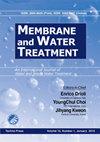Continuous removal of heavy metals by coupling a microbial fuel cell and a microbial electrolytic cell
IF 1.1
4区 工程技术
Q4 ENGINEERING, CHEMICAL
引用次数: 0
Abstract
This work aims at studying the feasibility of continuous removal of mixed heavy metal ions from simulated zinc plating wastewaters by coupling a microbial fuel cell and a microbial electrolysis cell in batch and continuous modes. The discharging voltage of MFC increased initially from 0.4621 ± 0.0005 V to 0.4864 ± 0.0006 V as the initial concentration of Cr6+ increased from 10 ppm to 60 ppm. Almost complete removal of Cr6+ and low removal of Cu2+ occurred in MFC of the MFC-MEC-coupled system after 8 hours under the batch mode; removal efficiencies (REs) of Cr6+ and Cu2+ were 99.76% and 30.49%. After the same reaction time, REs of nickel and zinc ions were 55.15% and 76.21% in its MEC. Cu2+, Ni2+, and Zn2+ removal efficiencies of 54.98%, 30.63%, 55.04%, and 75.35% were achieved in the effluent within optimum HRT of 2 hours under the continuous mode. The incomplete removal of Cu2+, Ni2+ and Zn2+ ions in the effluent was due to the fact that the Cr6+ was almost completely consumed at the end of MFC reaction. After HRT of 12 hours, at the different sampling locations, Cr6+ and Cu2+ removal efficiencies in the cathodic chamber of MFC were 89.95% and 34.69%, respectively. 94.58%, 33.95%, 56.57%, and 75.76% were achieved for Cr6+, Cu2+, Ni2+ and Zn2+ in the cathodic chamber of MEC. It can be concluded that those metal ions can be removed completely by repeatedly passing high concentration of Cr6+ through the cathode chamber of MFC of the MFC-MEC-coupled system.通过耦合微生物燃料电池和微生物电解电池连续去除重金属
本工作旨在研究通过将微生物燃料电池和微生物电解池以间歇和连续模式耦合,连续去除模拟镀锌废水中混合重金属离子的可行性。当Cr6+的初始浓度从10ppm增加到60ppm时,MFC的放电电压从0.4621±0.0005V初始增加到0.4864±0.0006V。在分批模式下,MFC-MEC耦合系统的MFC在8小时后几乎完全去除Cr6+,并且Cu2+的去除率较低;Cr6+和Cu2+的去除率分别为99.76%和30.49%。在相同的反应时间后,其MEC中镍和锌离子的去除率为55.15%和76.21%。在连续模式下,在2小时的最佳HRT内,出水中Cu2+、Ni2+和Zn2+的去除率分别为54.98%、30.63%、55.04%和75.35%。流出物中Cu2+、Ni2+和Zn2+离子的不完全去除是由于在MFC反应结束时Cr6+几乎被完全消耗。HRT 12小时后,在不同的采样位置,MFC阴极室中Cr6+和Cu2+的去除率分别为89.95%和34.69%。在MEC的阴极室中,Cr6+、Cu2+、Ni2+和Zn2+的去除率分别为94.58%、33.95%、56.57%和75.76%。可以得出结论,通过使高浓度的Cr6+重复通过MFC-MEC耦合系统的MFC的阴极室,可以完全去除这些金属离子。
本文章由计算机程序翻译,如有差异,请以英文原文为准。
求助全文
约1分钟内获得全文
求助全文
来源期刊

Membrane Water Treatment
ENGINEERING, CHEMICAL-WATER RESOURCES
CiteScore
1.90
自引率
30.00%
发文量
0
审稿时长
>12 weeks
期刊介绍:
The Membrane and Water Treatment(MWT), An International Journal, aims at opening an access to the valuable source of technical information and providing an excellent publication channel for the global community of researchers in Membrane and Water Treatment related area. Specific emphasis of the journal may include but not limited to; the engineering and scientific aspects of understanding the basic mechanisms and applying membranes for water and waste water treatment, such as transport phenomena, surface characteristics, fouling, scaling, desalination, membrane bioreactors, water reuse, and system optimization.
 求助内容:
求助内容: 应助结果提醒方式:
应助结果提醒方式:


